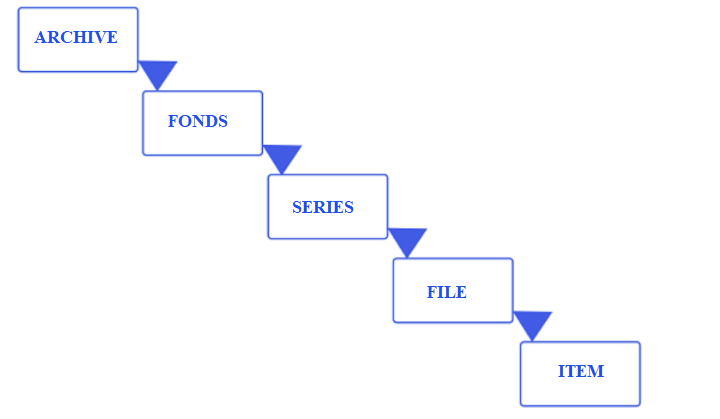Archival description
The website contains archival materials from state archives and other institutions.
Each archival material is part of a larger group of archives that create a MULTILEVEL STRUCTURE. This is how archivists organize and describe archival materials. It facilitates the processing and then sharing with the users millions of documents, photos and other items that the archives receive every year. Below you can see what this structure looks like. It is worth getting acquainted with it in order to search for materials on the website more effectively. The structure has several levels:

- Archive – an institution that stores materials. Some examples of archives include the Central Archives of Modern Records, the National Digital Archives or the State Archives in Kalisz. Part of state archives have their branches (one or more) with their own separate records (list of materials). For instance, the State Archives in Warsaw have as many as five branches located in Grodzisk Mazowiecki, Łowicz, Mława, Otwock and Pułtusk. Each of the branches has its own separate number. If you are looking for a specific material, it will be useful to know in which archive it is stored. The list of materials from each archive can be found on its subpage on the website in the "List of fonds" tab.
- Fonds - it is most often the institution / person that has produced the materials. It may be an office (e.g. Urząd Miasta Kutna [the City Hall of Kutno]) or a private person (e.g. Archiwum Fotograficzne Wacława Żdżarskiego [the Photographic Archive of Wacław Żdżarski]). There are also fonds that create collections of materials having a certain common feature (e.g. Zbiór dokumentów pergaminowych [the Collection of Parchment Documents]).
- Series – a group of files arranged according to specific criteria. In the case of offices, these may be, for example, their individual branches, and in the case of photography - the subject matter of pictures. Series can be extensive and multi-level, so it is easiest to treat them as a structure of catalogues that allow you to find the right material.
- File – a single, physically separated material that has been included in the archive - it can be a folder, register or collection of photographs relating to a specific event. Usually, it is a collection of documents, photographs or other materials related to a given topic.
- Item – sometimes archivists decide to divide files even further and describe one by one individual photographs or documents that make up the file - these smallest parts are called items.
This structure is reflected in the reference code - the registration number, which is used on the website. It contains each of the elements of the structure, for example:
53/5435/0/7/135/1
where:
53 – is the number of the archive = Archiwum Państwowe w Poznaniu [State Archives in Poznań]
5435/0 - is the number of the fonds = Fundacja 750-lecia lokacji miasta Poznania [Foundation of the 750th Anniversary of the City of Poznań ]
7 – 7 is the number of the series = Dokumentacja projektów [All projects documentation]
135 – 135 is the number of the file = Dokumentacja projektu: Dni Pyrlandii 2004 [Individual project documentation: Pyrlandia Days 2004]
1 – is the number of the item = Zaproszenie na Dni Pyrlandii 2004 Poznań - Łęgi Dębińskie [Invitation to Pyrlandia Days 2004 Poznań - Łęgi Dębińskie]
If you already know the reference code, you can easily search for it - just enter it into the search window and click on the magnifying glass or press enter.
On the website you will find descriptions of materials prepared by archivists and the scans attached to them.
- Not all materials have scans, but more and more of them are uploaded every year.
- Remember that even if you do not find scans on the website, they may be added in the near future - it is worth asking the appropriate archive about it. In some cases, the scans are not shared due to legal restrictions, you will also get this information in the archive. In some cases, the scans are not shared due to legal restrictions, you will also get this information in the archive.
- The description itself is also valuable information - it tells you that the material is in a given archive and can be viewed directly in its reading room. For this purpose, it is worth writing down its reference code. Remember, however, that some materials may be shared only with authorized persons - in this case, the archive employees will explain how to proceed.
- You can also order such a material directly to the reading room via the Search the Archives website. For more information please go to the "User account functions" tab.

